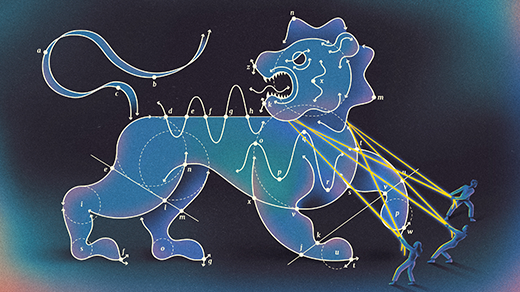Topology 101: The Hole Truth

Maggie Chiang for Quanta Magazine
Introduction
If you’re looking to pick a fight, simply ask your friends, “Is Pluto a planet?” Or “Is a hotdog a sandwich?” Or “How many holes does a straw have?” The first two questions will have them arguing yay or nay, while the third yields claims of two, one and even zero.
These questions all hinge on definitions. What is the precise definition of a planet? A sandwich? A hole? We will leave the first two for your friends to argue about. The third, however, can be viewed through a mathematical lens. How have mathematicians — particularly topologists, who study spatial relationships — thought about holes?
In everyday language, we use “hole” in a variety of nonequivalent ways. One is as a cavity, like a pit dug in the ground. Another is as an opening or aperture in an object, like a tunnel through a mountain or the punches in three-ring binder paper. Yet another is as a completely enclosed space, such as an air pocket in Swiss cheese. A topologist would say that all but the first example are holes. But to understand why – and why mathematicians even care about holes in the first place — we have to travel through the history of topology, starting with how it differs from its close kin, geometry.
In geometry, shapes like circles and polyhedra are rigid objects; the tools of the trade are lengths, angles and areas. But in topology, shapes are flexible things, as if made from rubber. A topologist is free to stretch and twist a shape. Even cutting and gluing are allowed, as long as the cut is precisely reglued. A sphere and a cube are distinct geometric objects, but to a topologist, they’re indistinguishable. If you want a mathematical justification that a T-shirt and a pair of pants are different, you should turn to a topologist, not a geometer. The explanation: They have different numbers of holes.
Leonhard Euler kicked off the topological investigation of shapes in the 18th century. You might think that by then mathematicians knew almost all there was to know about polyhedra. But in 1750, Euler discovered what I consider one of the all-time great theorems: If a polyhedron has F polygonal faces, E edges and V vertices, then V – E + F = 2. For example, a soccer ball has 20 white hexagonal and 12 black pentagonal patches for a total of 32 faces, as well as 90 edges and 60 vertices. And, indeed, 60 – 90 + 32 = 2. This elementary observation has deep connections to many areas of mathematics and yet is simple enough to be taught to kindergartners. But it eluded centuries of geometers like Euclid, Archimedes and Kepler because the result does not depend on geometry. It depends only on the shape itself: It is topological.
Euler implicitly assumed his polyhedra were convex, meaning a line segment joining any two points stayed completely within the polyhedron. Before long, scholars found nonconvex exceptions to Euler’s formula. For instance, in 1813 the Swiss mathematician Simon Lhuilier recognized that if we punch a hole in a polyhedron to make it more donut-shaped, changing its topology, then V – E + F = 0.
Samuel Velasco/Quanta Magazine
Interestingly, while Euler and Lhuilier imagined their polyhedra as solid, Euler’s formula is computed using only zero-dimensional vertices, one-dimensional edges and two-dimensional faces. So Euler’s number (V – E + F) actually derives from the two-dimensional surface of the polyhedron. Today, we would imagine these shapes as hollow shells.
Moreover, all that matters is the topology of the object. If we make a polyhedron out of clay, mark the edges with a Sharpie, and roll it into a ball, the faces and edges become curved but their number doesn’t change. So for any shape that is topologically a sphere, its Euler number is 2; for a donut-like torus, it’s 0; for a flat disk it’s 1; and so on. Each surface has its own Euler number. This topological understanding of Euler’s formula — in which the shapes were rubber-like and not rigid — was first presented in an article by Johann Listing in 1861. Although largely forgotten today, Listing is also notable for writing about the Möbius band four years before August Möbius, and for coining the very term topologie.
The Euler number, V – E + F, for a sphere is 2, a torus is 0, a disk is 1, and a double torus is –2.
Around the same time, Bernhard Riemann was studying surfaces that arose in his study of complex numbers. He observed that one way of counting holes was by seeing how many times the object could be cut without producing two pieces. For a surface with boundary, such as a straw with its two boundary circles, each cut must begin and end on a boundary. So, according to Riemann, because a straw can be cut only once — from end to end — it has exactly one hole. If the surface does not have a boundary, like a torus, the first cut must begin and end at the same point. A hollow torus can be cut twice — once around the tube and then along the resulting cylinder — so by this definition, it has two holes.
A straw can be cut once without disconnecting it, and a hollow torus can be cut twice.
Henri Poincaré was the next to build on, and greatly expand, the study of topology, when he published the groundbreaking 123-page article “Analysis Situs” in 1895. In it and its five sequels, he planted numerous topological seeds that would grow, blossom and bear fruit for decades to come. Notable among these was the concept of homology, which Poincaré introduced to generalize Riemann’s ideas to higher dimensions. Through homology, Poincaré aimed to capture everything from Riemann’s one-dimensional circle-like holes in a straw or binder paper, to the two-dimensional cavity-like holes inside Swiss cheese, and beyond to higher dimensions. The number of these holes — one for each dimension — became known as the Betti numbers of the object in honor of Enrico Betti, a friend of Riemann’s who had attempted similar work.
The modern definition of homology is quite involved, but it is roughly a means of associating to each shape a certain mathematical object. From this object we can extract simpler information about the shape, like its Betti numbers or its Euler number.
To get a sense of what homology and Betti numbers are, let’s focus on dimension one. We’ll start by looking at loops on a surface. The rules are simple: The loops can slip and slide around, and can even cross themselves, but they cannot leave the surface. On some surfaces, like a circular disk or a sphere, any loop can shrink down to a single point. Such spaces have trivial homology. But other surfaces, like a straw or a torus, have loops that wrap around their holes. These have nontrivial homology.
The torus shows us how to visualize Betti numbers. We can produce infinitely many nontrivial loops on one, and they can wind, double back and wrap around multiple times before ending at their starting point. But rather than producing a chaotic mess, these loops possess an elegant mathematical structure. Let’s call a loop that goes through the central hole and around the tube once “a.” That now serves as the basis for more loops. Since a loop can go around the tube once, twice or any number of times, and direction matters, we can represent those loops as a, 2a, –a, and so on. Not every loop is a multiple of a, however, such as the loop going around the central hole along the tube’s long circumference, which we can call “b.” At this point, though, there are no more unique trips: Any loop on the torus can be deformed to follow loops a and b some integer number of times. That there are two one-dimensional loops from which all others can be built means that the Betti number of the torus in dimension one is 2, the same as the number of Riemann’s cuts.
The torus has infinitely many different loops on its surface. The oriented loops a, b, and c are all different, but c can be deformed to obtain the union of loops a and b.
If loop c is equivalent to loop a combined with loop b, we write c = a + b. This expression is not just a notational convenience. It’s possible to make this arithmetic — the addition and subtractions of loops — rigorous. In mathematical lingo, a set that allows addition and subtraction is called a group. So on the torus, for example, the one-dimensional homology group consists of expressions such as 7a + 5b, 2a – 3b, and so on.
Fittingly, the group structure of homology was discovered in the 1920s by Emmy Noether, a pioneer of the study of groups and other algebraic structures. Thanks to Noether’s observation, mathematicians can now harness the power, structure and theorems of algebra to understand topology. For instance, we can say with mathematical certainty that a straw, a T-shirt and a pair of pants are all topologically different objects because their homology groups are different. In particular, they have a different number of holes.
So, finally, how do topologists count holes? Using the Betti numbers. The zeroth Betti number, b0, is sort of a special case. It simply counts the number of objects. So for a single connected shape, b0 = 1. As we just saw, the first Betti number, b1, is the number of circular holes in a shape — like the circle around the cylindrical straw, the three holes in binder paper and the two circular directions of the torus. And Poincaré showed us how to compute homology, and thus the associated Betti numbers, in higher dimensions as well: The second Betti number, b2, is the number of cavities — like those inside a sphere, a torus and Swiss cheese. More generally, bn counts the number of n-dimensional holes.
Remarkably, Poincaré’s homology brings us full circle back to Euler. Just as Euler’s number for a surface can be computed with vertices, edges and faces, it can also be computed with its Betti numbers: b0 – b1 + b2. The torus, for instance, is connected, so b0 = 1; it has b1 = 2, as we’ve seen; and, because it has one internal cavity, b2 = 1. Just as Lhuilier noted, the Euler number of the torus is 1 – 2 + 1 = 0.
Although mathematicians have had a basic understanding of homology for almost a century, algebraic topology continues to be an active research area further binding together algebra and topology. Researchers have also been branching out in other directions, developing the theory and algorithms necessary to compute the homology of shapes that are represented digitally, building tools to identify the underlying shape of large data sets (which often reside in high-dimensional spaces), and so on.
Yet others have been applying these theoretical tools to real-world applications. Imagine, for example, a scattered collection of small, low-cost sensors that detect something — movement, fire, gaseous emissions — within some fixed coverage radius. The sensors don’t know their locations, but they do know which other sensors are nearby. In 2007 Vin de Silva and Robert Ghrist showed how to use homology to detect holes in the sensors’ coverage, based on just this crude information. In a more recent paper, Michelle Feng and Mason Porter used a new technique called persistent homology to detect political islands — geographical holes in one candidate’s support that serve as spots of support for the other candidate — in California during the 2016 presidential election.
Thus, as with so many areas of pure mathematics that began as mere theoretical musings, topology has proved its real-world worth, and not just for settling the question of how many holes a straw has.



